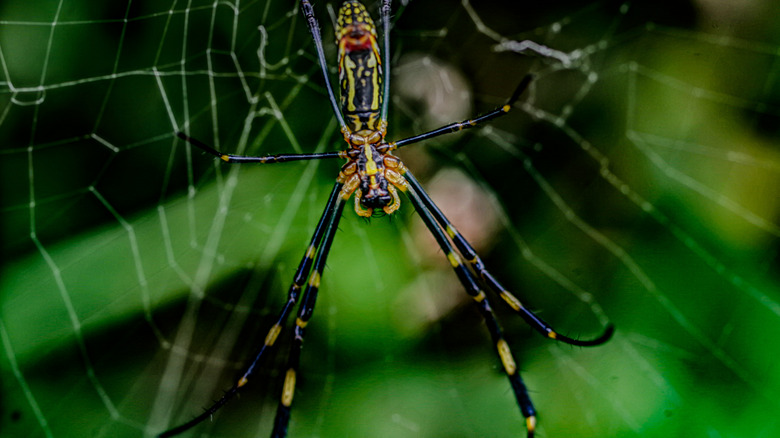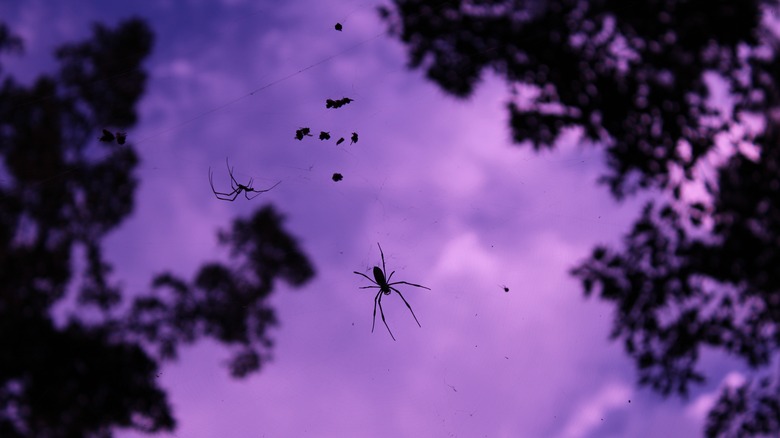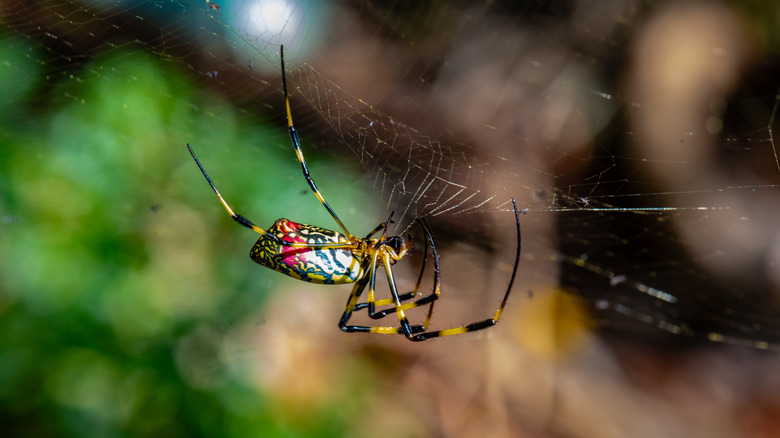The Invasive Baby Spider That Uses Wind To 'Fly'
As if spiders didn't already inspire fear among the masses, you might have heard about "flying" venomous arachnids making their way up the East Coast of the United States. In reality, the Joro spider (Trichonephila clavata) can't actually fly and isn't venomous enough to cause humans any real harm. But it certainly caused concern in 2024 after experts warned the species was spreading through eastern states. Luckily, the spider isn't all that aggressive, though it does engage in some unique behavior, using its own silk threads to catch the wind and float from place to place.
The Joro spider is actually native to East Asia, but like so many invasive species in the U.S., it found its way to America likely by way of a shipping container. Back in 2013, an example of the species was sighted in Georgia, and ever since, the predator has spread to other areas and states, prompting concerns about its impact on native species. Further research into the consequences of the Joro invasion is ongoing, but in the meantime, we can at least disperse with the notion that these non-native predators will be flying into our faces and neutralizing us all with deadly toxins.
More generally, though, the Joro spider is part of the golden orb-weaver family of arachnids which spin large, strong webs. This means the species is capable of feeding on larger prey than other spiders, including stink bugs and other pests. The Joro's unique black and yellow coloration also make it instantly recognizable, but this is far from the only unique thing about the species, which uses its floating method, known as "ballooning," to travel around and spread to new areas.
Joro spiders float rather than fly, but there's nothing to fear
You might be concerned to hear about "flying" spiders entering the United States, but that's not quite an accurate description of the Joro spider. For one thing, this species only uses its ballooning method of travel when young. The technique involves spiderlings spinning a line of web and casting it out to catch the wind. They then use the line as a sort of kite to glide to a new destination. Adult Joro spiders are too large and heavy to use this method (fully-grown Joros can reach up to 4 inches in diameter, including their leg span). Interestingly enough, research published in 2018 in the journal Current Biology found that spiders capable of ballooning would do so more regularly in the presence of electric fields (e-fields) in the air.
So does this mean you might suddenly be overcome by clouds of baby spiders flying through the air? Not really, no. Aside from the fact these tiny arachnids will likely carry out all their ballooning without anyone ever really noticing, there's also the fact that Joro spiders are — unlike the world's biggest spider species that you'd never want to see in your house — actually relatively timid. A 2023 study published in the journal Arthropoda tested how spiders reacted to disturbances, and found that while many spiders responded by freezing in place for under a minute, Joros stayed still for more than an hour.
What's more, Joro venom isn't actually all that harmful, to humans, at least. The spider's toxin is designed to incapacitate its insect prey, but humans who get bitten will feel less pain than they would with a bee sting. Those susceptible to allergic reactions will, however, likely have a much more serious experience. Otherwise, the Joro spider is relatively harmless to humans, and it doesn't even seem all that interested in attacking us when provoked,.
Do Joro spiders in the United States actually pose a threat?
Invasive species have already destroyed ecosystems across the United States, so any newly introduced species is going to be cause for concern. As of now, however, it's not entirely clear just how destructive the Joro spider might be.
In August 2025, The Great Smoky Mountains National Park posted a warning to its Facebook page, urging visitors to upload images of any Joro spiders they see in the park, which spans areas of North Carolina and Tennessee. The post noted how populations of native orb weavers will likely be adversely affected by the arrival of the Asian spiders and reiterated the need for observation and control of the invaders.
On a similar front, a 2023 study published in the journal Ecology and Evolution noted that the Joro spider appeared to be "spreading faster to the north than to the south" due to the fact that northern states more closely mimic its native climate. More importantly, the researchers had a hard time identifying different spiders in the region; in other words, there were lower numbers and less diversity of native orb weaver spiders in areas near where Joro spiders had been found, suggesting they are already having a significant impact on native species.
Experts are also looking into how Joro spiders might impact pollinators including honey bees, and biologists at Valdosta State University, who have studied spider diets, have noted that Joros appear to feast on any insects that happen to get caught in their webs. This suggests pollinators might well be at risk. Otherwise, more research is needed to really gain a full understanding of how the Joro spider might impact natural environments and native species in the U.S.


